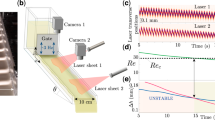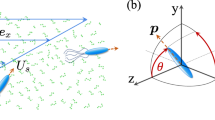Abstract
Suspensions are of wide interest and form the basis for many smart fluids1,2,3,4,5,6,7. For most suspensions, the viscosity decreases with increasing shear rate, that is, they shear thin. Few are reported to do the opposite, that is, shear thicken, despite the longstanding expectation that shear thickening is a generic type of suspension behaviour8,9. Here we resolve this apparent contradiction. We demonstrate that shear thickening can be masked by a yield stress and can be recovered when the yield stress is decreased below a threshold. We show the generality of this argument and quantify the threshold in rheology experiments where we control yield stresses arising from a variety of sources, such as attractions from particle surface interactions, induced dipoles from applied electric and magnetic fields, as well as confinement of hard particles at high packing fractions. These findings open up possibilities for the design of smart suspensions that combine shear thickening with electro- or magnetorheological response.
This is a preview of subscription content, access via your institution
Access options
Subscribe to this journal
Receive 12 print issues and online access
$259.00 per year
only $21.58 per issue
Buy this article
- Purchase on Springer Link
- Instant access to full article PDF
Prices may be subject to local taxes which are calculated during checkout





Similar content being viewed by others
References
Stanway, R. Smart fluids. Nature Sci. Tech. 20, 931–939.
Wen, W., Huang, X., Yang, S., Lu, K. & Sheng, P. The giant electrorheological effect in suspensions of nanoparticles. Nature Mater. 2, 727–730 (2003).
Trappe, V., Prasad, V., Cipelletti, L., Segre, P. N. & Weitz, D. A. Jamming phase diagram for attractive particles. Nature 411, 772–775 (2001).
Jolly, M. R., Bender, J. W. & Carlson, J. D. SPIE 5th Annual Int. Symposium on Smart Structures and Materials (1998).
Lee, Y. S., Wetzel, E. D. & Wagner, N. J. The ballistic impact characteristics of Kevlar—woven fabrics impregnated with a colloidal shear thickening fluid. J. Mater. Sci. 38, 2825–2833 (2003).
Shenoy, S. S., Wagner, N. J. & Bender, J. W. E-FiRST: Electric field responsive shear thickening fluids. Rheol. Acta 42, 287–294 (2003).
Zhang, X., Li, W. & Gong, X. L. Study on magnetorheological shear thickening fluid. Smart Mater. Struct. 17, 015051 (2008).
Barnes, H. A. Shear-thickening (‘Dilatancy’) in suspensions of nonaggregating solid particles dispersed in Newtonian liquids. J. Rheol. 33, 329–366 (1989).
Brady, J. F. & Bossis, G. The rheology of concentrated suspensions of spheres in simple shear flow by numerical simulation. J. Fluid Mech. 155, 105–129 (1985).
Maranzano, B. J. & Wagner, N. J. The effects of particle size on reversible shear thickening of concentrated colloidal suspensions. J. Chem. Phys. 114, 10514–10527 (2001).
Hoffmann, R. L. Discontinuous and dilatant viscosity behaviour in concentrated suspensions III. Necessary conditions for their occurrence in viscometric flows. Adv. Colloid Interface Sci. 17, 161–184 (1982).
Lootens, D., Van Damme, H., Hémar, Y. & Hébraud, P. Dilatant flow of concentrated suspensions of rough particles. Phys. Rev. Lett. 95, 268302 (2005).
Fall, A., Huang, N., Bertrand, F., Ovarlez, G. & Bonn, D. Shear thickening of cornstarch suspensions as a reentrant jamming transition. Phys. Rev. Lett. 100, 018301 (2008).
Galley, W. & Puddington, I. E. The hydration of starch below the gelatinization temperature. Can. J. Res. C 21, 179–185 (1943).
Gopalakrishnan, V. & Zukoski, C. F. Effect of attractions on shear thickening in dense suspensions. J. Rheol. 48, 1321–1344 (2004).
Brown, E. & Jaeger, H. M. Dynamic jamming point for shear thickening suspensions. Phys. Rev. Lett. 103, 086001 (2009).
Egres, R. G. & Wagner, N. J. The rheology and microstructure of acicular precipitated calcium carbonate colloidal suspensions through the shear thickening transition. J. Rheol. 49, 719–746 (2005).
Head, D. A., Ajdari, A. & Cates, M. E. Jamming, hysteresis, and oscillation in scalar models for shear thickening. Phys. Rev. E 64, 061509 (2001).
Sellito, M. & Kurchan, J. Shear-thickening and entropy-driven reentrance. Phys. Rev. Lett. 95, 236001 (2005).
Bergenholtz, J., Brady, J. F. & Vivic, M. The non-Newtonian rheology of dilute colloidal suspensions. J. Fluid Mech. 456, 239–275 (2002).
Melrose, J. R. & Ball, R. C. Continuous shear thickening transitions in model concentrated colloids—the role of interparticle forces. J. Rheol. 48, 937–960 (2004).
Osuji, C. O., Kim, C. & Weitz, D. A. Shear thickening and scaling of the elastic modulus in a fractal colloidal system with attractive interactions. Phys. Rev. E 77, 060402 (2008).
Lootens, D., Van Damme, H. & Hébraud, P. Giant stress fluctuations at the jamming transition. Phys. Rev. Lett. 90, 178301 (2003).
Pryce-Jones, J. Experiments on thixotropic and other anomalous fluids with a new rotation viscometer. J. Sci. Instrum. 18, 39–48 (1941).
Jolly, M. R. & Bender, J. W. Field responsive shear thickening fluid. US patent 20060231357 (2001).
Rolland, J. P. et al. Direct fabrication and harvesting of monodisperse, shape-specific nanobiomaterials. J. Am. Chem. Soc. 127, 10096–10100 (2005).
Acknowledgements
This work was supported by DARPA through Army grant W911NF-08-1-0209. E.B. acknowledges further support by the NSF MRSEC programme under DMR-0820054. We thank J. Xu for carrying out the optical tweezer measurements, K. Herlihy and J. Nunes for help with the magnetite-containing particle synthesis, L. Mair and R. Superfine for assistance with optical microscope images in calibrated magnetic fields and J. Sprague and M. Hunter for assistance with manufacturing of PRINT particles.
Author information
Authors and Affiliations
Contributions
E.B. and H.M.J. conceived of the study and wrote the manuscript. All team members were involved in conception of manufactured particles that show both a magnetorheological and shear-thickening effect. H.Z., N.A.F., D.E.B. and J.M.D. were responsible for design and initial fabrication of these particles. N.A.F., B.W.M. and J.M.D. were responsible for production of gram quantities of these particles. E.B. and C.S.O. were responsible for the rheological measurements. E.B. analysed the data.
Corresponding author
Ethics declarations
Competing interests
Joseph DeSimone and Benjamin Maynor have an interest in Liquidia Technologies, which has licensed the PRINT technology
Supplementary information
Supplementary Information
Supplementary Information (PDF 324 kb)
Rights and permissions
About this article
Cite this article
Brown, E., Forman, N., Orellana, C. et al. Generality of shear thickening in dense suspensions. Nature Mater 9, 220–224 (2010). https://doi.org/10.1038/nmat2627
Received:
Accepted:
Published:
Issue Date:
DOI: https://doi.org/10.1038/nmat2627
This article is cited by
-
Effect of DLVO interactions on the rheology and microstructure of non-Brownian suspensions
Acta Mechanica Sinica (2023)
-
Development of cornstarch-based shear thickening fluid and characterization of the effects of the addition of halloysite nanotubes-silica hybrid reinforcements
Journal of Polymer Research (2023)
-
The combined effect of matrix molecular weight, filler concentration, and filler-matrix interactions on the dynamic viscoelasticity of polydimethylsiloxane/clay composites
Rheologica Acta (2023)
-
Energy polydisperse 2d Lennard–Jones fluid in the presence of flow field
Pramana (2022)
-
Avoiding surface instability and slurry jamming in simultaneous multilayer coating of structured particulate films
Journal of Coatings Technology and Research (2022)



